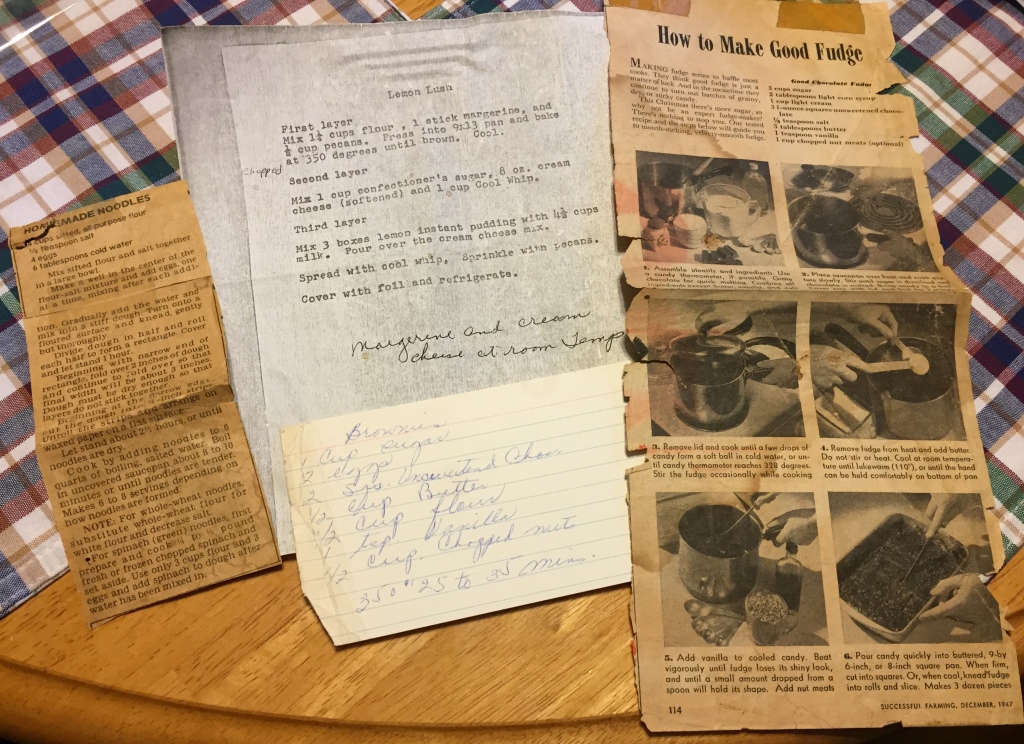By: Jennifer Howard, KHS Librarian
Q:

Dear Kentucky Historical Society,
With the Christmas season upon us, I find myself concerned, once again, about the heirloom recipes in my family’s collection. We cook from them every year, and each year they become more brittle. I don’t want to lose the originals, but would also like a practical way to share the recipes with other family members. Can you give me some advice regarding the original recipe condition, and how best to share without contributing to the decay each year?
Sincerely,
Recipe Betty
A:
Ironically Betty, I was presented with the same question from a member of my own family. A few months ago, my mother asked me about framing one of my grandmother’s recipes. As the holidays near, a framed recipe would make a great family-themed gift, but many recipes which have been handed down through the years are made from materials that will not last long-term. Scanning the original recipe and making a digital print for framing can be an alternative solution.
I imagine your family’s recipes are a lot like mine – written or typed on everything: actual recipe cards, plain index cards, newspaper and magazine clippings, actual cookbooks, and various other materials.
So the first question to ask is, what type of paper is the original, and is that material going to last? Newspapers start to turn yellow and brittle after a few years, much less decades, and many other types of paper also have what archivists call “inherent vice,” which means that even left alone and stored properly, the item is just going to continue degrading.
If the recipe is a type of material that’s going to continue to degrade, framing the original will not help preserve it. In fact, displaying the item can actually damage the item further, since it will be exposed to light more often.
What can you do? In our very digital world, an easy answer is to make a scanned copy. That will give you a digital version to share with family and friends, and you can make a print for framing.

Here are a few digitization recommendations:
- File types:
o Tiff – Stable format. Produces large, high quality images.
- Great for preservation.
o Jpg – Unstable format. Produces highly compressed digital files.
- Great for sharing.
- Scanning specs:
o High Quality- 600 dpi, 24 bit color, uncompressed Tiff file (20+ MB file size)
o Medium Quality- 300 dpi, 24 bit color, uncompressed Tiff or jpg
o Low Quality- 150 dpi, 24 bit color, jpg
- Notes:
o If the item you’re scanning is smaller than 3.5 x 5, you may need to scan at a higher dpi
o If your scanner does not have a tiff option, scan as jpeg and then immediately save as a tiff file
Once you have your scan, store the original in a place with fairly stable temperatures and humidity. You can also purchase archival folders or boxes for storage. See “Caring for Family and Private Collections” from the Northeast Document Conservation Center (NEDCC) for environmental and storage suggestions: https://www.nedcc.org/free-resources/preserving-private-and-family-collections/caring-for-private-and-family-collections.
Since you’ll now be framing a print instead of the original, you can weigh the importance of using archival inks, paper, and framing materials versus their cost and availability. If you are interested, the NEDCC also has recommendations on matting and framing and making long-lasting prints:
- https://www.nedcc.org/free-resources/preservation-leaflets/4.-storage-and-handling/4.10-matting-and-framing-for-art-and-artifacts-on-paper
- https://www.nedcc.org/free-resources/preservation-leaflets/5.-photographs/5.4-creating-long-lasting-inkjet-prints
For me, the most important part of choosing how the print will look is matching the original recipe. Therefore I would probably choose to print in color (unless it’s a black & white original), and would choose glossy paper if the original was a magazine clipping or something glossy. Your framed version may fade over time, but if you try to follow guidelines for storing the original, and maintain your high-quality tiff file scan, you’ll be able to make a new print as needed over the years.
Jennifer Howard is a Librarian at KHS, and is involved in a variety of tasks including reference, cataloging, systems and acquisitions. Jennifer has a B. A. in History and Religious Studies from Western Kentucky University in Bowling Green, Kentucky. She received a Master of Library and Information Science from University of Kentucky. She joined the staff of the Kentucky Historical Society in 2007.
After realizing what occurred free sample merely need to remember that the that nil desire alter.

